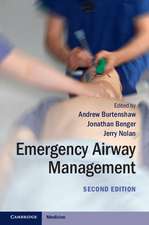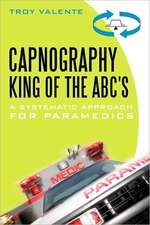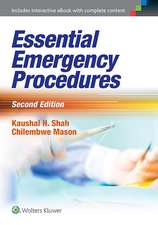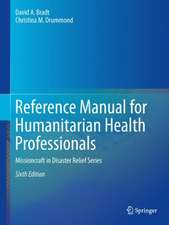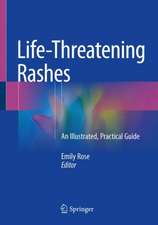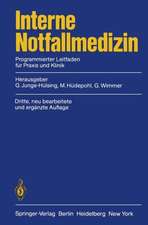Clinical Examination Skills in the Adult Critically Ill Patient
Editat de Martin W. Dünser, Daniel Dankl, Sirak Petros, Mervyn Meren Limba Engleză Paperback – 19 dec 2018
The skill of physical examination has become the forgotten art of medicine in both undergraduate and postgraduate studies. Furthermore, most books on the topic have so far focused on examination practices applicable to non-critically ill patients. In emergency and intensive care medicine, however, a different approach and sometimes also different examination techniques are required due to the life-threatening disease process. In summarizing knowledge and providing guidance on physical examination in this specific subgroup of patients, this book will meet the needs of all physicians and allied health care professionals involved in the care of critically ill patients.
| Toate formatele și edițiile | Preț | Express |
|---|---|---|
| Paperback (1) | 671.62 lei 39-44 zile | |
| Springer International Publishing – 19 dec 2018 | 671.62 lei 39-44 zile | |
| Hardback (1) | 933.81 lei 39-44 zile | |
| Springer International Publishing – 3 sep 2018 | 933.81 lei 39-44 zile |
Preț: 671.62 lei
Preț vechi: 706.97 lei
-5% Nou
Puncte Express: 1007
Preț estimativ în valută:
128.52€ • 137.43$ • 107.15£
128.52€ • 137.43$ • 107.15£
Carte tipărită la comandă
Livrare economică 14-19 aprilie
Preluare comenzi: 021 569.72.76
Specificații
ISBN-13: 9783030084394
ISBN-10: 3030084396
Pagini: 261
Ilustrații: XIII, 261 p. 236 illus., 226 illus. in color.
Dimensiuni: 178 x 254 mm
Greutate: 0.72 kg
Ediția:Softcover reprint of the original 1st ed. 2018
Editura: Springer International Publishing
Colecția Springer
Locul publicării:Cham, Switzerland
ISBN-10: 3030084396
Pagini: 261
Ilustrații: XIII, 261 p. 236 illus., 226 illus. in color.
Dimensiuni: 178 x 254 mm
Greutate: 0.72 kg
Ediția:Softcover reprint of the original 1st ed. 2018
Editura: Springer International Publishing
Colecția Springer
Locul publicării:Cham, Switzerland
Cuprins
Foreword.- Preface.- Part I. General approach to the critically ill patient.- Basic principles.- The first impression.- Checking vital functions.- Recognizing pre-terminal signs.- Part II. Examining single organ systems.- The airway and lungs.- The circulation.- The brain.- The abdomen.- The liver.- The hydration status and the kidneys.- The neuromuscular system and spinal cord.- The coagulation.- Part III. Systematic examination schemes.- The patient in respiratory distress.- The patient in shock.- The patient with a neurological disease.- The patient with severe trauma.- The patient with a suspected infection.- The patient in cardiac arrest.- The intoxicated patient.- During the ICU ward round.- Part IV. Appendix. Dermatological pearls for the intensivist.
Recenzii
“The major strength of the book is that it is so easy to use. The illustrations and guidance will help readers to perform clinical examinations in a structured way. … The book would be of value for clinicians in any intensive care unit, emergency room, and for physicians and paramedics working in the prehospital field.” (Ann Merete Møller, Anesthesia & Analgesia, Vol. 130 (1), January, 2020)
“Providers at all levels practicing in the disciplines caring for medical and surgical critical illness in the adult will find this guide useful. Because of the wide range of problems examined, surgeons, anesthesiologists, and internists will be able to find information on presentation and typical examination findings for problems relevant to their normal scope of practice.” (David J. Dries, Doody's Book Reviews, June 14, 2019)
“Providers at all levels practicing in the disciplines caring for medical and surgical critical illness in the adult will find this guide useful. Because of the wide range of problems examined, surgeons, anesthesiologists, and internists will be able to find information on presentation and typical examination findings for problems relevant to their normal scope of practice.” (David J. Dries, Doody's Book Reviews, June 14, 2019)
Notă biografică
Martin W. Dünser is vice-director of the Department of Anesthesiology and Intensive Care Medicine of the Kepler University Hospital in Linz, Austria. He was trained in anesthesia, intensive care and emergency medicine and worked as an intensive care consultant in Bern (Switzerland), Salzburg (Austria) and London (United Kingdom). He is a pre-hospital emergency physician for the Austrian Red Cross and worked for London’s Air Ambulance. In addition to his clinical work, Dr. Dünser is interested in medical work in low- and middle-income countries and has been involved in field work in Africa and Asia. He was co-founder and chair of the Global Intensive Care working group of the European Society of Intensive Care Medicine (ESICM). He serves as co-chair of the Sepsis in Resource-Limited Nations initiative of the Surviving Sepsis Campaign. He was deputy chair and chair of the Trauma and Emergency Medicine section and is a past member of the Research as well as the Congress Committeeof the ESICM. Dr. Dünser is a reviewer for numerous journals and author of over 180 scientific articles.
Daniel Dankl is consultant at the Department of Anesthesiology and Intensive Care Medicine of the Paracelsus Medical University in Salzburg/Austria. He was trained in internal medicine, intensive care medicine, emergency medicine and anaesthesia in Rheine/Germany, Wels/Austria and Salzburg/Austria. He also worked as a pre-hospital emergency physician for the Austrian Red Cross. Daniel has a special interest in the physical and ultrasound examination of the critically ill patient and renal replacement techniques in intensive care.
Sirak Petros is director of the Medical Intensive Care Unit and the Center of Haemostaseology at the University Hospital of Leipzig in Leipzig/Germany. After graduating in medicine from the Gondar College of Medical Sciences in Gondar/Ethiopia, he completed his residency in internal medicine at the University Hospital of Leipzig. Dr. Petros was trained in gastroenterology, intensive care medicine, emergency medicine, and haemostaseology. Since then he has worked as a consultant both in intensive care medicine and haemostaseology; he also served as director of the Comprehensive Hemophilia Care Center at the University Hospital of Leipzig.
Mervyn Mer, MBBCh, Dip PEC (SA), FCP (SA), Pulmonology subspecialty, M Med (Int Med), Cert Critical Care (SA), FRCP (London), FCCP (USA), PhD, is a Principal Specialist in the Department of Medicine, Divisions of Critical Care and Pulmonology at the Charlotte Maxeke Johannesburg Academic Hospital and Faculty of Health Sciences, University of the Witwatersrand, Johannesburg, South Africa. He is a specialist physician, pulmonologist and intensivist. Dr. Mer is a hands-on-clinician as well as being involved in various aspects of clinical research. He is the immediate Past President of the Critical Care Society of Southern Africa (CCSSA), having served three terms, current vice-President of the Southern African Society of Thrombosis and Haemostasis, and recently appointed Chairperson of the Global Intensive Care Working Group of the European Society of Intensive Care Medicine (ESICM). He has lectured widely on a global level and is a reviewer for several journals. Mervyn has been the recipient of several awards, amongst others, the Phillip V. Tobias and Convocation Clinical Award for Distinguished Teaching (highest teaching award offered by the Faculty of Health Sciences, University of the Witwatersrand), the President’s Award of the Critical Care Society of Southern Africa (highest award offered by the CCSSA for outstanding contributions to Critical Care), and the Sam Naidoo Award for the best clinician, conferred by the Southern African Society of Thrombosis and Haemostasis. More recently, he was the first recipient of the Hilda Datnow Jacobson award (awarded to the most competent, caring and capable doctor in the profession, irrespective offield of interest).
Daniel Dankl is consultant at the Department of Anesthesiology and Intensive Care Medicine of the Paracelsus Medical University in Salzburg/Austria. He was trained in internal medicine, intensive care medicine, emergency medicine and anaesthesia in Rheine/Germany, Wels/Austria and Salzburg/Austria. He also worked as a pre-hospital emergency physician for the Austrian Red Cross. Daniel has a special interest in the physical and ultrasound examination of the critically ill patient and renal replacement techniques in intensive care.
Sirak Petros is director of the Medical Intensive Care Unit and the Center of Haemostaseology at the University Hospital of Leipzig in Leipzig/Germany. After graduating in medicine from the Gondar College of Medical Sciences in Gondar/Ethiopia, he completed his residency in internal medicine at the University Hospital of Leipzig. Dr. Petros was trained in gastroenterology, intensive care medicine, emergency medicine, and haemostaseology. Since then he has worked as a consultant both in intensive care medicine and haemostaseology; he also served as director of the Comprehensive Hemophilia Care Center at the University Hospital of Leipzig.
Mervyn Mer, MBBCh, Dip PEC (SA), FCP (SA), Pulmonology subspecialty, M Med (Int Med), Cert Critical Care (SA), FRCP (London), FCCP (USA), PhD, is a Principal Specialist in the Department of Medicine, Divisions of Critical Care and Pulmonology at the Charlotte Maxeke Johannesburg Academic Hospital and Faculty of Health Sciences, University of the Witwatersrand, Johannesburg, South Africa. He is a specialist physician, pulmonologist and intensivist. Dr. Mer is a hands-on-clinician as well as being involved in various aspects of clinical research. He is the immediate Past President of the Critical Care Society of Southern Africa (CCSSA), having served three terms, current vice-President of the Southern African Society of Thrombosis and Haemostasis, and recently appointed Chairperson of the Global Intensive Care Working Group of the European Society of Intensive Care Medicine (ESICM). He has lectured widely on a global level and is a reviewer for several journals. Mervyn has been the recipient of several awards, amongst others, the Phillip V. Tobias and Convocation Clinical Award for Distinguished Teaching (highest teaching award offered by the Faculty of Health Sciences, University of the Witwatersrand), the President’s Award of the Critical Care Society of Southern Africa (highest award offered by the CCSSA for outstanding contributions to Critical Care), and the Sam Naidoo Award for the best clinician, conferred by the Southern African Society of Thrombosis and Haemostasis. More recently, he was the first recipient of the Hilda Datnow Jacobson award (awarded to the most competent, caring and capable doctor in the profession, irrespective offield of interest).
Textul de pe ultima copertă
This well-illustrated book provides detailed guidance on all aspects of physical examination in patients requiring emergency or intensive care. After an introductory section covering basic principles and the recognition of pre-terminal signs, the approach to examination of individual organ systems is clearly explained. Examination schemes are then presented for particular conditions or settings, including respiratory distress, shock, neurological disease, trauma, suspected infection, and cardiac arrest.
The skill of physical examination has become the forgotten art of medicine in both undergraduate and postgraduate studies. Furthermore, most books on the topic have so far focused on examination practices applicable to non-critically ill patients. In emergency and intensive care medicine, however, a different approach and sometimes also different examination techniques are required due to the life-threatening disease process. In summarizing knowledge and providing guidance onphysical examination in this specific subgroup of patients, this book will meet the needs of all physicians and allied health care professionals involved in the care of critically ill patients.
The skill of physical examination has become the forgotten art of medicine in both undergraduate and postgraduate studies. Furthermore, most books on the topic have so far focused on examination practices applicable to non-critically ill patients. In emergency and intensive care medicine, however, a different approach and sometimes also different examination techniques are required due to the life-threatening disease process. In summarizing knowledge and providing guidance onphysical examination in this specific subgroup of patients, this book will meet the needs of all physicians and allied health care professionals involved in the care of critically ill patients.
Caracteristici
Describes how physical examination in patients requiring emergency or intensive care differs from that in other patients Explains the approach to examination of individual organ systems Presents examination schemes for different conditions and settings






